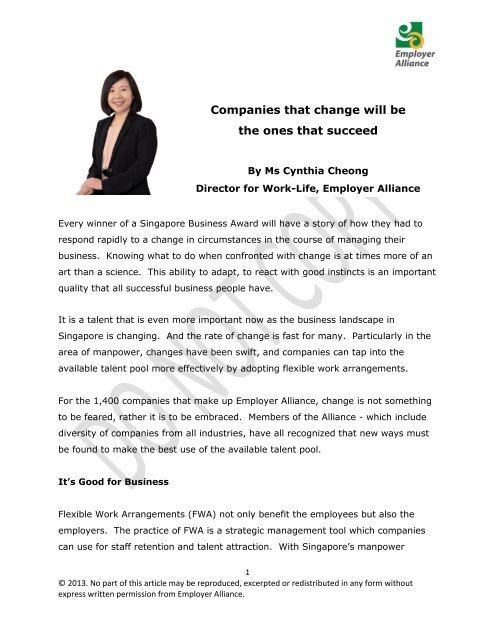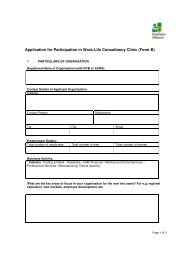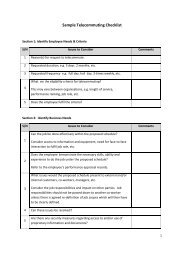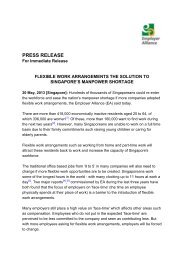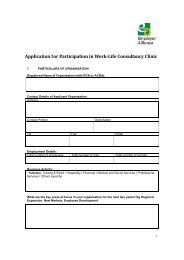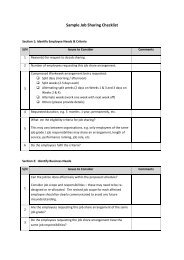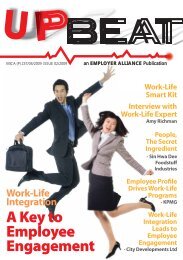Companies that change will be the ones that succeed
Companies that change will be the ones that succeed
Companies that change will be the ones that succeed
Create successful ePaper yourself
Turn your PDF publications into a flip-book with our unique Google optimized e-Paper software.
<strong>Companies</strong> <strong>that</strong> <strong>change</strong> <strong>will</strong> <strong>be</strong><br />
<strong>the</strong> <strong>ones</strong> <strong>that</strong> <strong>succeed</strong><br />
By Ms Cynthia Cheong<br />
Director for Work-Life, Employer Alliance<br />
Every winner of a Singapore Business Award <strong>will</strong> have a story of how <strong>the</strong>y had to<br />
respond rapidly to a <strong>change</strong> in circumstances in <strong>the</strong> course of managing <strong>the</strong>ir<br />
business. Knowing what to do when confronted with <strong>change</strong> is at times more of an<br />
art than a science. This ability to adapt, to react with good instincts is an important<br />
quality <strong>that</strong> all successful business people have.<br />
It is a talent <strong>that</strong> is even more important now as <strong>the</strong> business landscape in<br />
Singapore is changing. And <strong>the</strong> rate of <strong>change</strong> is fast for many. Particularly in <strong>the</strong><br />
area of manpower, <strong>change</strong>s have <strong>be</strong>en swift, and companies can tap into <strong>the</strong><br />
available talent pool more effectively by adopting flexible work arrangements.<br />
For <strong>the</strong> 1,400 companies <strong>that</strong> make up Employer Alliance, <strong>change</strong> is not something<br />
to <strong>be</strong> feared, ra<strong>the</strong>r it is to <strong>be</strong> embraced. Mem<strong>be</strong>rs of <strong>the</strong> Alliance - which include<br />
diversity of companies from all industries, have all recognized <strong>that</strong> new ways must<br />
<strong>be</strong> found to make <strong>the</strong> <strong>be</strong>st use of <strong>the</strong> available talent pool.<br />
It’s Good for Business<br />
Flexible Work Arrangements (FWA) not only <strong>be</strong>nefit <strong>the</strong> employees but also <strong>the</strong><br />
employers. The practice of FWA is a strategic management tool which companies<br />
can use for staff retention and talent attraction. With Singapore’s manpower<br />
1<br />
© 2013. No part of this article may <strong>be</strong> reproduced, excerpted or redistributed in any form without<br />
express written permission from Employer Alliance.
crunch, <strong>the</strong> companies who offer FWAs have access to talent which o<strong>the</strong>rwise may<br />
not <strong>be</strong> available.<br />
Benefits of incorporating flexible work practices to <strong>the</strong> company include:<br />
<br />
<br />
<br />
Maximising Talent: companies who can retain experienced and competent<br />
talent <strong>will</strong> have an edge and <strong>will</strong> <strong>be</strong> able to build a talent pipeline; it also<br />
provides companies with a competitive edge in recruitment:<br />
Increased productivity: Engaged employees <strong>will</strong> have more than an economic<br />
contract with <strong>the</strong>ir employers. They <strong>will</strong> <strong>be</strong> more involved and <strong>will</strong>ing to go<br />
<strong>the</strong> extra mile and take ownership when <strong>the</strong>y know <strong>that</strong> <strong>the</strong>ir well <strong>be</strong>ing<br />
matters to <strong>the</strong>ir employer;<br />
Cost savings: With higher retention, companies save time and money spent<br />
in recruitment, and continuous training of new hires. There <strong>will</strong> also <strong>be</strong><br />
savings in downtime as new hires <strong>will</strong> also take time to build up <strong>the</strong>ir<br />
knowledge and experience. Mobile work, in particular, may result in savings<br />
in real estate.<br />
Flexible Work Practices Are Now Essential<br />
When companies do introduce new workplace practices <strong>that</strong> allow employees to<br />
achieve <strong>be</strong>tter integration of <strong>the</strong>ir work and personal aspirations; <strong>the</strong>y can attract<br />
many more people to work for <strong>the</strong>m as well as keep <strong>the</strong> employees <strong>the</strong>y already<br />
have.<br />
When considering how to implement more flexible practices it helps to consider job<br />
roles in three dimensions - time, location and workload.<br />
Time<br />
The time when work is done can vary with <strong>the</strong> intention of optimising individuals’<br />
performances at work and in <strong>the</strong>ir lives. There are many ways this can <strong>be</strong> done,<br />
2<br />
© 2013. No part of this article may <strong>be</strong> reproduced, excerpted or redistributed in any form without<br />
express written permission from Employer Alliance.
ut commonly companies may provide flexible hours, staggered hours,<br />
compressed work weeks to name a few. Staggered hours, for example, can result<br />
in extended operating hours, enabling companies to serve its regional customers<br />
<strong>be</strong>tter.<br />
Location<br />
The second factor to consider is <strong>that</strong> of location and where work is done. Flexible<br />
work arrangements <strong>that</strong> allow an employee to work remotely or on <strong>the</strong> road can<br />
increase productivity as it reduces commute time and pockets of waiting time. To<br />
ensure success, both employees, supervisors and co-workers should establish good<br />
communication practices and performance objectives and enhance collaboration<br />
abilities of <strong>the</strong> team.<br />
Some industries are already reaping <strong>the</strong> <strong>be</strong>nefits of home-based work or mobile<br />
work. Today’s technology makes it possible for teams to <strong>be</strong> connected virtually,<br />
sharing ideas and responding to clients remotely. This has <strong>the</strong> added bonus of cost<br />
savings on office rent and o<strong>the</strong>r overheads.<br />
Workload<br />
The third area to consider is workload. <strong>Companies</strong> may design roles based on<br />
competencies to recruit part-time or home-based employees in addition to<br />
traditional job matching.<br />
In Singapore, for this to evolve, part-time work needs to <strong>be</strong> given greater<br />
recognition and afforded <strong>the</strong> same status as fulltime work. This means career<br />
opportunities as well as training and development have to <strong>be</strong> comparable to full<br />
time employees, though scaled according to <strong>the</strong> performance outcomes <strong>that</strong> are<br />
required from <strong>the</strong> part-time employees.<br />
Interim work is ano<strong>the</strong>r concept <strong>that</strong> is increasingly common in America, Britain,<br />
Australia and o<strong>the</strong>r parts of <strong>the</strong> world, but is less common in Asia. Interim<br />
3<br />
© 2013. No part of this article may <strong>be</strong> reproduced, excerpted or redistributed in any form without<br />
express written permission from Employer Alliance.
employees can <strong>be</strong> very senior managers, brought in to fill a critical gap in a<br />
company's leadership or for a fixed term to manage projects.<br />
As <strong>the</strong>y are not caught up in <strong>the</strong> day to day issues of <strong>the</strong> company, interim<br />
managers can take a step back and focus on <strong>the</strong> critical issues <strong>that</strong> lead to a<br />
project's success. It may <strong>be</strong> easier to find an interim employee than it is to move<br />
an existing employee into a short-term project position. In some cases interim<br />
employees may subsequently <strong>be</strong> offered a permanent position.<br />
Untapped Talent Pools<br />
By analysing work along <strong>the</strong> dimension of time, location and load, a num<strong>be</strong>r of<br />
possibilities open up to introduce flexible arrangements <strong>that</strong> <strong>be</strong>nefit <strong>the</strong> company.<br />
Once <strong>the</strong>se arrangements are in place, companies <strong>will</strong> find <strong>the</strong>y have access to a<br />
whole new group of potential employees. By offering flexible work arrangements<br />
such as working from home or part-time work, <strong>the</strong> size of <strong>the</strong> talent pool a<br />
company can access greatly increases. In today’s tight labour market, <strong>the</strong> ability to<br />
do so is definitely a competitive strength.<br />
According to <strong>the</strong> Labour Force Survey, it is estimated <strong>that</strong> in June 2012, around<br />
418,000 residents aged 25 to 64 were economically inactive. Of <strong>the</strong>se, four in five,<br />
or about 336,000, were women. Many of <strong>the</strong>se people left full time employment at<br />
an age when <strong>the</strong>y are highly skilled and productive.<br />
Employers should ask <strong>the</strong>mselves how <strong>the</strong>y can tap into this reservoir of talent by<br />
making working arrangements flexible enough so <strong>that</strong> a parent can contribute<br />
economically as well as raise a family.<br />
4<br />
© 2013. No part of this article may <strong>be</strong> reproduced, excerpted or redistributed in any form without<br />
express written permission from Employer Alliance.
A Win-Win for Employer and Employees<br />
Giving employees <strong>the</strong> flexibility to look after both <strong>the</strong>ir work and life aspirations <strong>will</strong><br />
make <strong>the</strong>m <strong>be</strong>tter and more stable contributors to a business, so both parties<br />
<strong>be</strong>nefit from <strong>the</strong> arrangement. The experience of many of <strong>the</strong> mem<strong>be</strong>rs of<br />
Employer Alliance is <strong>that</strong> employees <strong>be</strong>come more productive, more loyal and more<br />
committed to <strong>the</strong> business when <strong>the</strong>y know <strong>the</strong>ir family’s needs can also <strong>be</strong> taken<br />
care of.<br />
There are enormous possibilities available to companies <strong>that</strong> embrace flexible work<br />
practices. Improvements in productivity and loyalty, toge<strong>the</strong>r with a reduction in<br />
staff turnover and unfilled positions are just some of <strong>the</strong> <strong>be</strong>nefits companies <strong>will</strong><br />
experience. Embracing flexible work practices <strong>will</strong> streng<strong>the</strong>n a company and<br />
enable it to respond to <strong>change</strong>s when <strong>the</strong>y occur. And this <strong>will</strong> set <strong>the</strong> company on<br />
<strong>the</strong> right path for <strong>the</strong> future both in Singapore and <strong>be</strong>yond our shores.<br />
Success Factors for Flexible Work Adoption<br />
1. Tone Setting by Management – A top-down acceptance and strong<br />
encouragement of flexible work fosters a culture which reduces <strong>the</strong><br />
barriers to implementation.<br />
2. Reorganisation of Work – Take a more dynamic view on how work is<br />
organised. Use clear job descriptions and set measurable key<br />
performance indicators o<strong>the</strong>r than face-time.<br />
3. Empower and Equip Managers – Managers can enhance <strong>the</strong> company’s<br />
drive on flexible work adoption. It’s vital to equip <strong>the</strong>m with <strong>the</strong> skills<br />
and tools which <strong>will</strong> help <strong>the</strong>m to build trust and overcome face time<br />
issues when dealing with employees.<br />
5<br />
© 2013. No part of this article may <strong>be</strong> reproduced, excerpted or redistributed in any form without<br />
express written permission from Employer Alliance.
4. Ongoing Education and Communication – Communicate <strong>the</strong> business<br />
case for flexible work adoption and <strong>the</strong> successes achieved to<br />
encourage greater buy-in.<br />
The Employer Alliance is a network of over 1400 mem<strong>be</strong>r companies committed to<br />
creating an enabling environment to enhance Work-Life Integration. The Executive<br />
Committee of Employer Alliance is chaired by Ms Claire Chiang, SVP Banyan Tree<br />
Holdings and mem<strong>be</strong>rs include Liak Teng Lit, Group CEO, Alexandra Health; Helen<br />
Lim-Yang, Sr Partner, Capelle Consulting; Bert Wong, President and Sr MD Fuji<br />
Xerox; Janet Ang, MD IBM Singapore; Stephen Tjoa, Executive Director, People,<br />
Performance & Culture KPMG; Pollie Sim, CEO Maybank Singapore; Patrick Ang, Dy<br />
Managing Partner Rajah & Tann; Douglas Foo, CEO Sakae Holdings and Jeanne<br />
Cheng, MD SP Services. All are Work-Life award achievers, continuously learning to<br />
create innovative work practices to meet <strong>the</strong> talent needs in our changing<br />
demographic landscape.<br />
Employer Alliance (EA) is a network of corporations committed to <strong>the</strong> creation of an enabling<br />
work environment to enhance Work-Life Integration. Mem<strong>be</strong>rship is free.<br />
To join EA or find out more, please email admin@employeralliance.sg or call 6837 8631.<br />
6<br />
© 2013. No part of this article may <strong>be</strong> reproduced, excerpted or redistributed in any form without<br />
express written permission from Employer Alliance.


